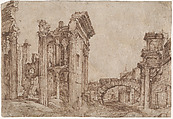The Ruins of the Forum of Nerva, Rome, seen from the South-West
Matthijs Bril the Younger Netherlandish
Not on view
This image of the ruins of the Forum of Nerva (or Forum Transitorium) in Rome viewed from the southwest, with the tower of the Church of Saints Quirico and Giulitta in the background, is one of at least four versions of the same exact view.[1] An autograph sheet by Matthijs Bril in the Louvre (inv. 20958) seems to have served as the model for the others—copies by artists who had access to Matthijs’s original, even after his death, in the studio of his brother, Paul Bril, in Rome. So closely does the present drawing compare with the Louvre sheet, however, that it may be a repetition by Matthijs Bril himself, possibly made for sale while the original was preserved in the studio.
Various views of the Forum of Nerva had been, and would continue to be, produced by Netherlandish artists, among them Maarten van Heemskerck (Kupferstich-Kabinett, Staatliche Museen zu Berlin) and Pieter Lastman (Rijksmuseum, Amsterdam).
[1] The other known versions are in the Louvre (inv. 20958 and inv. 20957) and in the Devonshire collection at Chatsworth (inv. 847), the last attributed to Jan Brueghel I. Another, now untraced, was sold at C.G. Boerner, Leipzig, November 7, 1929, no. 41 (not illustrated); see Frits Lugt, Inventaire général des dessins des écoles du Nord, publié sous les auspices du Cabinet des dessins. École flamande (Paris, Musée nationaux, 1949), vol. 1, p. 18, no. 359. On these drawings and on the practice of copying in the Bril studio, see Louisa Wood Ruby, Paul Bril: The Drawings (Brepols: 1999), pp. 9, 28-29.
Due to rights restrictions, this image cannot be enlarged, viewed at full screen, or downloaded.


